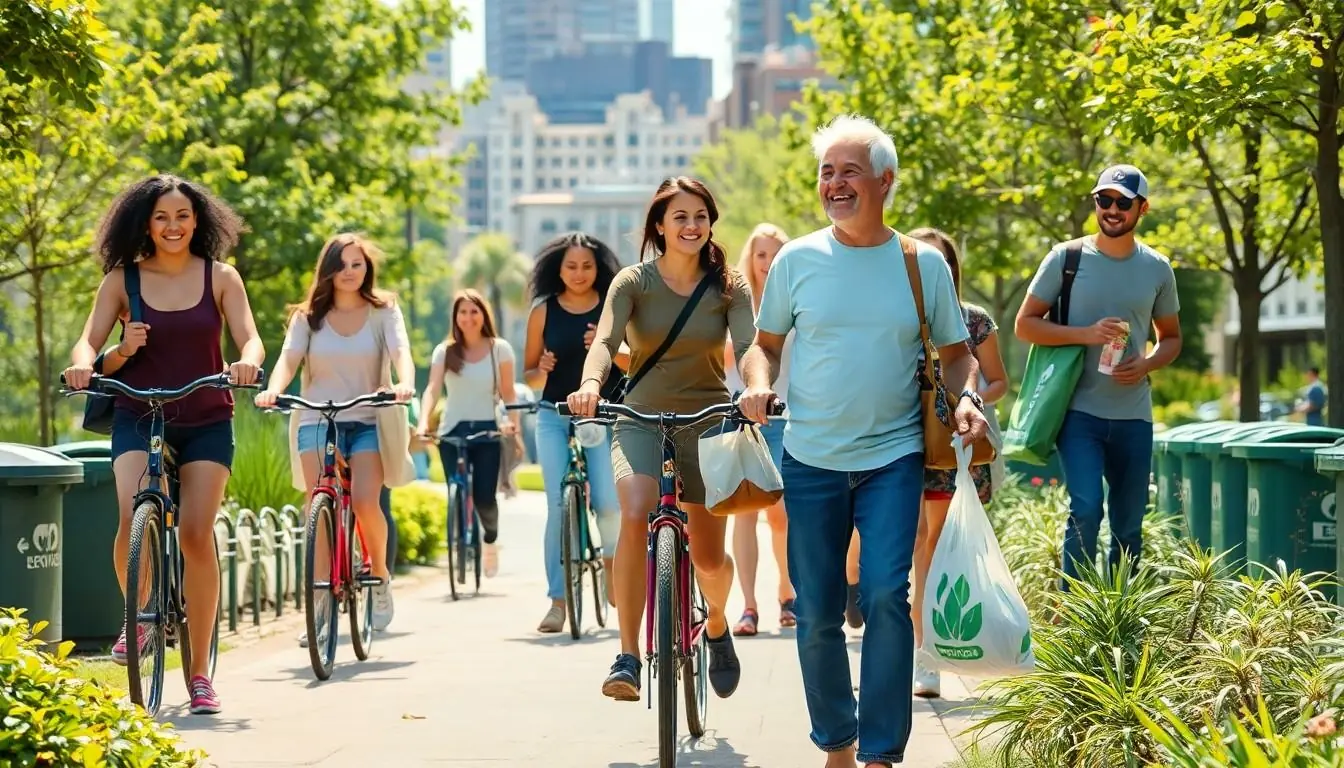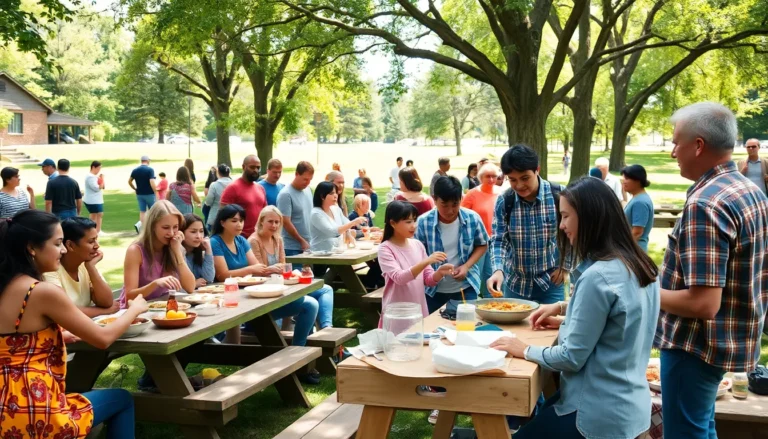Table of Contents
ToggleIn a world where plastic bags outnumber the stars and climate change feels like an unwelcome houseguest, sustainable living isn’t just a trend—it’s a necessity. But don’t worry, saving the planet doesn’t mean giving up your morning coffee or trading your car for a bicycle with a basket. It’s about making smarter choices that add up over time.
Understanding Sustainable Living
Sustainable living focuses on reducing an individual’s or society’s environmental impact. This practice emphasizes conserving resources, minimizing waste, and promoting environmental health through everyday choices.
Definition of Sustainable Living
Sustainable living refers to a lifestyle that aims to minimize an individual’s or society’s use of Earth’s natural resources. Each decision, from energy consumption to waste reduction, plays a critical role in this overall strategy. Engaging in sustainable practices involves embracing renewable energy sources, reducing plastic use, and supporting local economies. Individuals can achieve sustainability by making conscious choices that protect the environment while meeting personal needs.
Importance of Sustainability
Sustainability holds immense importance in today’s world. Climate change poses significant threats to ecosystems, weather patterns, and food security. Adopting sustainable practices helps combat these issues by reducing carbon footprints and preserving natural habitats. Through sustainable living, individuals contribute to healthier communities and ensure a better quality of life for future generations. Prioritizing sustainability leads to innovations in technology and practices that drive economic growth while protecting the planet’s resources.
Practical Tips for Sustainable Living

Making small changes in daily routines can significantly reduce environmental impact. Emphasizing resource conservation and waste reduction leads to more sustainable lifestyles.
Reducing Waste
Minimizing waste starts with smart purchasing decisions. Choose products with minimal packaging and opt for reusable alternatives like bags, bottles, and containers. Compost organic waste to divert it from landfills and enrich soil naturally. Participating in local recycling programs also makes a substantial difference. Educating others about waste reduction amplifies the collective effort toward sustainability.
Energy Efficiency
Prioritizing energy efficiency lowers utility bills while reducing carbon footprints. Switch to LED light bulbs, which use up to 75% less energy than traditional bulbs. Unplugging electronics when not in use prevents energy wastage. Investing in energy-efficient appliances can also lead to significant savings over time. Utilizing timers for lights and thermostats helps manage energy consumption effectively.
Sustainable Transportation
Opting for sustainable transportation methods reduces greenhouse gas emissions. Walking or biking for short trips promotes physical health and lowers carbon output. Public transportation provides an eco-friendly alternative for commuting; it decreases the number of vehicles on the road. Carpooling with colleagues or friends further maximizes efficiency and shares costs. Choosing electric or hybrid vehicles contributes to reduced reliance on fossil fuels.
Mindful Consumption
Mindful consumption focuses on making informed choices that benefit the environment and society. Small, everyday decisions can lead to significant change.
Choosing Eco-Friendly Products
Selecting eco-friendly products reduces harm to the environment. Look for items made from sustainable materials such as bamboo, recycled paper, or organic cotton. Prioritize products with minimal packaging to decrease waste. Certifications like Energy Star and USDA Organic indicate commitment to sustainability. Additionally, supporting brands that practice ethical sourcing helps promote fair labor and environmental practices. Consumers benefit by choosing durable, long-lasting products, which ultimately leads to less frequent replacements.
Supporting Local Businesses
Supporting local businesses strengthens communities and reduces carbon emissions by minimizing transportation distances. Choosing to shop at farmer’s markets ensures fresh, seasonal produce while helping local farmers. Community-based businesses often reinvest in the local economy, fostering job creation and resilience. Engaging with artisans and craftspeople allows consumers to purchase unique, handmade products instead of mass-produced alternatives. Local businesses also typically adhere to sustainable practices, contributing to healthier ecosystems. Ultimately, prioritizing local purchasing enhances both economic stability and environmental sustainability.
Sustainable Home Practices
Sustainable home practices significantly enhance eco-friendly living. These methods focus on conserving resources and minimizing waste.
Water Conservation
Water conservation plays a crucial role in sustainable living. Implementing low-flow fixtures helps reduce water usage in kitchens and bathrooms. Rain barrels collect rainwater for gardening, providing a natural watering source. Regular checks for leaks prevent unnecessary water waste and promote efficiency. Utilizing drought-resistant plants in landscaping reduces the demand for irrigation. Households benefit from scheduling outdoor watering during early morning or late evening when evaporation rates are lower. These small adjustments create substantial improvements in overall water conservation efforts.
Green Gardening
Green gardening emphasizes sustainable practices that benefit both the environment and the gardener. Native plants attract beneficial insects, promote biodiversity, and require less maintenance. Composting kitchen scraps enriches soil, while reducing waste sent to landfills. Organic fertilizers and pest control methods minimize chemical usage, protecting local ecosystems. Implementing drip irrigation systems delivers water efficiently to plants, reducing evaporation. Gardeners can also create a pollinator-friendly space by planting wildflower varieties. Such initiatives not only enhance gardens but also support local wildlife and improve air quality.
Community Involvement
Engagement with the community plays a vital role in fostering sustainable living. Local efforts not only create a collective impact but also strengthen social bonds.
Volunteering for Environmental Causes
Volunteering for environmental causes provides individuals with a hands-on opportunity to contribute. Participants can help with activities like park clean-ups, tree planting, or wildlife conservation projects. These initiatives promote awareness and educate the public on sustainability issues. Joining organizations focused on environmental stewardship enhances personal knowledge. Volunteers often meet like-minded individuals, fostering a shared purpose. Furthermore, involvement in these activities helps build stronger, more resilient communities dedicated to protecting their environment.
Participating in Local Initiatives
Participating in local initiatives encourages community members to take action for sustainability. Many towns host events like community gardens or sustainability fairs, which promote education and engagement. Joining local environmental advocacy groups strengthens voices that promote eco-friendly policies. Local workshops on composting, recycling, or water conservation provide practical skills. Engaging with neighbors in these activities fosters collaboration and shared learning. Communities that unite around sustainable principles can create lasting change and inspire others to follow suit.
Embracing sustainable living isn’t just a trend; it’s a necessary shift for the health of the planet. By making mindful choices and incorporating eco-friendly practices into daily routines, individuals can significantly reduce their environmental impact.
Every small step counts—from choosing reusable products to supporting local businesses. Community involvement also plays a crucial role in fostering a culture of sustainability.
Together, these actions can create a ripple effect, leading to healthier ecosystems and more resilient communities. As more people commit to sustainable living, they pave the way for a brighter future for generations to come.






